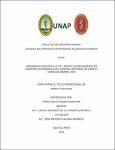Hemorragia digestiva alta y riesgo de resangrado en pacientes atendidos en el Hospital Regional de Loreto, enero-diciembre, 2019
Abstract
La hemorragia digestiva alta es una de las enfermedades más comunes en el servicio de gastroenterología, se trata del sangrado del aparato digestivo proveniente por encima del ángulo del Treitz. El objetivo general de esta investigación es evaluar las características de la hemorragia digestiva alta y el riesgo de resangrado en pacientes atendidos en el Hospital Regional de Loreto de enero a diciembre 2019. Se trató de un estudio observacional, descriptivo, retrospectivo y transversal. La población estuvo constituida por 162 pacientes. El proceso de recolección de datos fue revisión documentaria y el instrumento una de ficha de recolección de datos validada por juicio de expertos llenada con la información brindada en la historia clínica. El riesgo de resangrado se midió con el Índice de Rockall. Se realizó análisis descriptivo univariado y bivariado; se utilizó test de proporciones para determinar la relación entre las características de la hemorragia digestiva alta y el riesgo de resangrado. El riesgo de resangrado alto se asoció a: presentación clínica de shock hipovolémico (p=0,0001); hemoglobina de ingreso <7 gr/dL (p<0,0001); transfusión de 2 o más paquetes globulares (p<0,0001); HDA grave-severa (p<0,0001); consumo de alcohol y tabaco concomitantemente (p=0,0004); consumo de AINES (p<0,0001), estancia hospitalaria ≥5 días (p<0,0001); y las HDA de origen variceal (p<0,0001). La aplicación del Índice de Rockall sirve para identificar a los pacientes con alta predisposición al resangrado, darles un tratamiento oportuno y prevenir el fallecimiento. Upper gastrointestinal bleeding is one of the most common diseases in the gastroenterology service, it is bleeding from the digestive system from above the angle of the Treitz. The general objective of this research is to evaluate the characteristics of upper gastrointestinal bleeding and the risk of rebleeding in patients treated at the Regional Hospital of Loreto from January to December 2019. It was an observational, descriptive, retrospective and cross-sectional study. The population consisted of 162 patients. The data collection process was a documentary review and the instrument a data collection sheet validated by expert judgment filled with the information provided in the clinical history. The risk of rebleeding was measured with the Rockall Index. Descriptive univariate and bivariate analysis was performed; Proportions test was used to determine the relationship between the characteristics of upper gastrointestinal bleeding and the risk of rebleeding. The risk of high rebleeding was associated with: clinical presentation of hypovolemic shock (p = 0.0001); hemoglobin on admission <7 gr / dL (p <0.0001); transfusion of 2 or more blood cells (p <0.0001); Severe-severe HDA (p <0.0001); concomitant consumption of alcohol and tobacco (p = 0.0004); consumption of NSAIDs (p <0.0001), hospital stay ≥5 days (p <0.0001); and HDAs of variceal origin (p <0.0001). The application of the Rockall Index serves to identify patients with a high predisposition to rebleeding, give them timely treatment and prevent death.
Collections
- Tesis [374]

